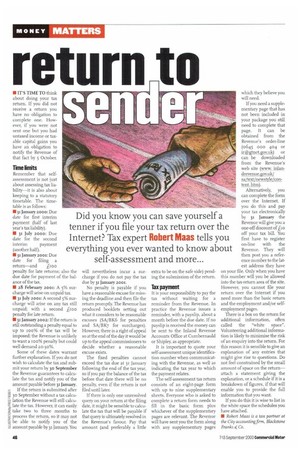return to
Page 48

If you've noticed an error in this article please click here to report it so we can fix it.
Did you know you can save yourself a tenner if you file your tax return over the Internet? Tax expert Robert Maas tells you everything you ever wanted to know about self-assessment and more...
• IT'S TIME TO think about doing your tax return. If you did not receive a return you have no obligation to complete one. However, if you were not sent one but you had untaxed income or taxable capital gains you have an obligation to notify the Revenue of that fact by 5 October.
Time limits
Remember that selfassessment is not just about assessing tax liability—it is also about keeping to a statutory timetable. The timetable is as follows;
• 31 January 2000: Due date for first interim payment (half of last year's tax liability).
• 31 .11.1ly 2000: Due date for the second
interim payment (another half).
• 31 January zoo': Due date for filing a return—and LIO0 penalty for late returns; also the due date for payment of the balance of the tax.
• 28 February zoo': A 5% surcharge will arise on unpaid tax.
• 31 July 2001: A second 5% surcharge will arise on any tax still unpaid; with a second Imo penalty for late return.
• 31 January 2002: lfthe return is still outstanding a penalty equal to up to i00% of the tax will be imposed; the Revenue is unlikely to want a TO o% penalty but could well demand 20-30%.
Some of these dates warrant further explanation. If you do not wish to calculate the tax and submit your return by 30 September the Revenue guarantees to calculate the tax and notify you of the amount payable before 31 January.
If the return is submitted after al 30 September without a tax calcu ▪ lation the Revenue will still calcu
late the tax. However, it can easily z take two to three months to
• process the return, so it may not
17,m be able to notify you of the amount payable by 31 January. You will nevertheless incur a surcharge if you do not pay the tax due by 31 January 2001.
No penalty is payable if you have a reasonable excuse for missing the de,adline and then file the return promptly. The Revenue has produced booklets setting out what it considers to be reasonable excuses (SA/BK6 for penalties and SA/BK7 for surcharges). However, there is a right of appeal so at the end of the day it would be up to the appeal commissioners to decide whether a reasonable excuse exists.
The fixed penalties cannot exceed the tax due at 3! January following the end of the tax year, so if you pay the balance of the tax before that date there will be no penalty, even if the return is not filed until later.
If there is only one unresolved query on your return at the filing date, it might be sensible to calculate the tax that will be payable if that query is ultimately resolved in the Revenue's favour. Pay that amount (and preferably a little extra to be on the safe side) pending the submission of the return.
Tax payment
It is your responsibility to pay the tax without waiting for a reminder from the Revenue. In practice the Revenue issues a reminder, with a payslip, about a month before the due date. If no payslip is received the money can be sent to the Inland Revenue Accounts Office at Cumbernauld or Shipley, as appropriate.
It is important to quote your self-assessment unique identification number when communicating with the Revenue, as well as indicating the tax year to which the payment relates.
The self-assessment tax return consists of an eight-page form with up to nine supplementary sheets. Everyone who is asked to complete a return form needs to fill in the basic form plus whichever of the supplementary pages are relevant. The Revenue will have sent you the form along with any supplementary pages which they believe you will need.
If you need a supplementary page that has not been included in your package you still need to complete that page. It can be obtained from the Revenue's order-line (060 000 404 or irPgtnet.gov.uk) or can be downloaded from the Revenue's web site (www. inlandrevenue.gov.uk/ saftextfriewstyle/contt tit. htm).
Alternatively, you can complete the form over the Internet. If you do this and pay your tax electronically by 31 January the Revenue will give you a one-off discount oflio off your tax bill. You first have to register on-line with the Revenue. They will then post you a reference number to the latest address they have on your file. Only when you have this number will you be allowed into the tax-return area of the site. However, you cannot file your return over the Internet if you need more than the basic return and the employment and selfemployment pages.
There is a box on the return for additional information, often called the "white space". Volunteering additional information is likely to minimise the risk of an enquiry into the return. For this reason it is sensible to give an explanation of any entries that might give rise to questions. Do not feel constrained by the small amount of space on the return attach a statement giving the explanation, or a schedule Wit is a breakdown of figures, if that will enable you to provide the full information that you want.
If you do this it is wise to list in the white space the schedules you have attached.
Robert Maas is a tax partner at the City accounting firm, Blackstone Franks ez Co.
















































































































